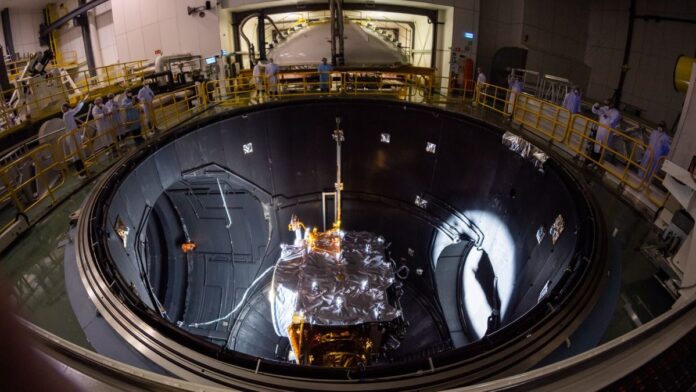Europe’s mission to explore three icy moons of Jupiter is all set to begin its voyage to the outer solar system.
The Jupiter Icy Moons Explorer spacecraft, also known as JUICE, will study Europa, Ganymede and Callisto to provide insights into their nature, evolution, possible subsurface oceans and the potential to harbor life. JUICE has been undergoing final testing at Airbus facilities in Toulouse, France, and will shortly begin its journey to ESA’s Guiana Space Center spaceport in French Guiana on South America’s Atlantic coast. From there, the 13,670-pound (6,200 kilograms) spacecraft will launch on one of the last two Ariane 5 rockets.
“The launch is currently targeted for the 14th of April,” the European Space Agency’s (ESA) Director General Josef Aschbacher said Tuesday (Jan. 24) during a news conference held in Paris.
Related: NASA spacecraft snaps gorgeous new photo of Jupiter’s moons Io and Europa
JUICE is scheduled to reach Jupiter in 2031 and will then make a series of flybys of the icy Galilean moons Europa, Ganymede and Callisto. It will finally enter orbit around Ganymede in 2034 to begin a more detailed, nine-month-long study of the moon, which will also be the first time a spacecraft orbits a moon other than our own.
JUICE will use its package of 10 cutting-edge science payloads to further our understanding of the moons. One major focus will be the internal subsurface oceans underneath the moons’ crusts, which JUICE will target by studying the moons’ magnetic fields and looking at their tidal interactions with other worlds in the Jupiter system.
“We are not monitoring fish or big fish or creatures in these lakes, but we are seeing how these moons are composed and whether they could be habitable or not,” Aschbacher said. “This will be extremely important information that might possibly lead to other future missions to the icy moons, which are extremely interesting from a science point of view.”
JUICE carries huge solar arrays with a total area of 915 square feet (85 square meters) to provide power for the spacecraft, which will be orbiting Jupiter at an average 484 million miles (778 million kilometers) away from the sun.
The mission will end when JUICE runs out of the fuel needed to maintain its orbit and impacts the surface of Ganymede.
JUICE was selected by ESA in 2012 and prime contractor Airbus worked with more than 80 companies across Europe to get the spacecraft ready.
Meanwhile, NASA is working to ready its Europa Clipper mission for launch in 2024. Europa is perhaps the most intriguing of the three JUICE moons for astrobiologists, and whereas the ESA mission will fly past Europa only twice, Clipper will execute dozens of flybys beginning around 2030.
Follow us on Twitter @Spacedotcom and on Facebook.

